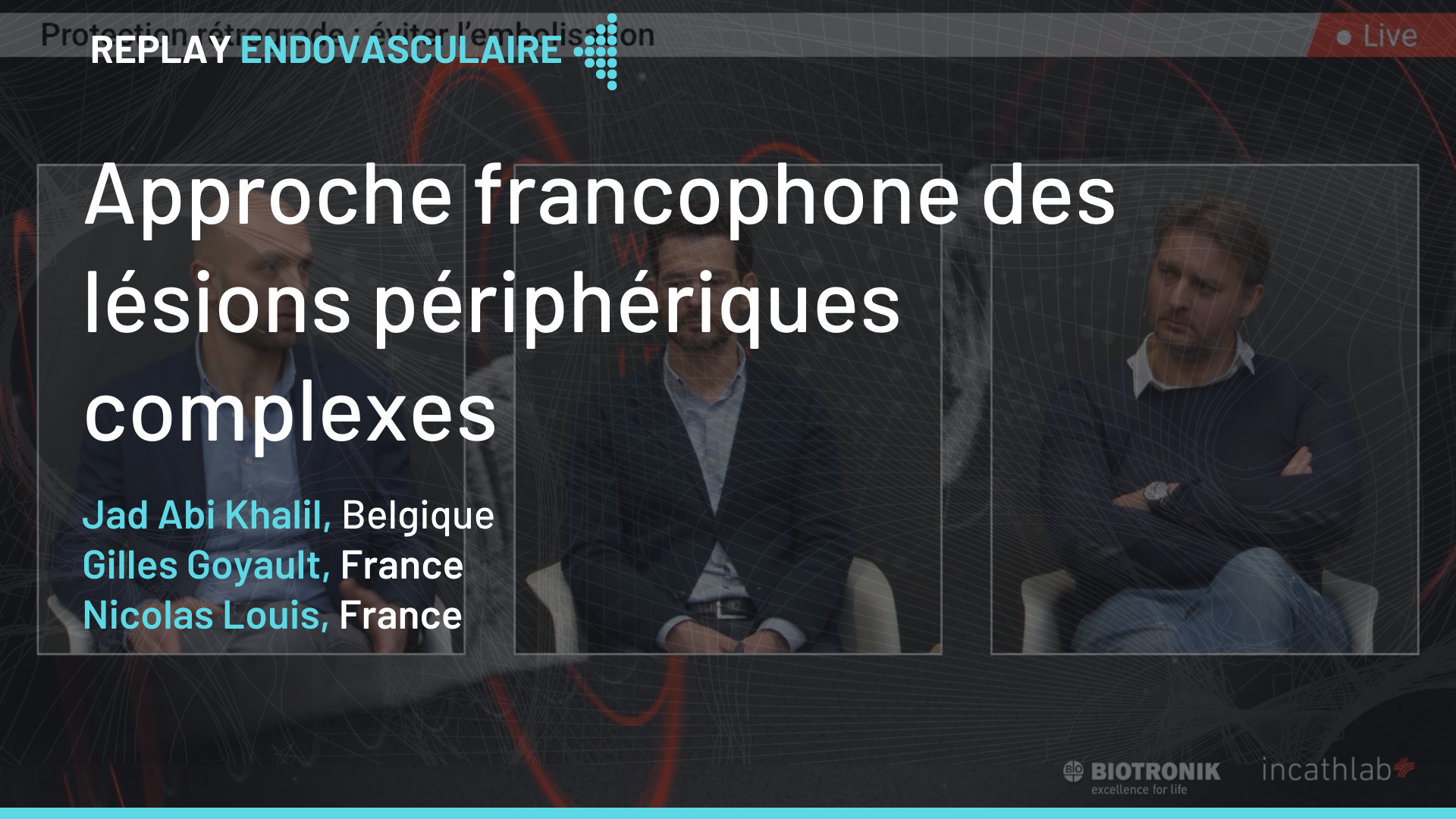
Become an Incathlab member and receive full access to its content!
Registration Login
Log in and attend the Controversies & Updates in Vascular Surgery congress live!
FREE & UNLIMITED ACCESS
CACVS is one of the major interactive post graduate course for vascular surgeons, cardiac surgeons, vascular radiologists and angiologists in Europe.
Enjoy two and a half days addressing all aspects of vascular diseases and their treatments.
Learn about the most recent available data about on-going or recently published trials, technical advances of open vascular or endovascular procedures and participate in debates on controversial topics.
Discover how international experts deal with the challenging clinical cases that will be presented.
Two parallel sessions will take place on Friday reviewing the most recent data on vascular access in the morning and on AAA and EVAR in the afternoon (detailed program on broadcast pages).
You will have access to both sessions selecting Main Auditorium or Room B broadcast below.
Depending on the language preferred on your incathlab account, you will attend in the English or French version.
After the conference, the VOD will be available with unlimited access.
AUDITORIUM MAIN SESSION - SCIENTIFIC PROGRAM
Thursday January 21st
13.45 Welcome address, Jean-Pierre Becquemin
14.00 Thoracic and Thoraco Abdominal Aneurysms - PART I
Chairmen: Jean-Pierre Becquemin, Piergiorgio Cao, Grzegorz Oszkinis, Ramesh Tripathi, Fabio Verzini
14.00 Expansion, risk of rupture: are our current guidelines still valid? Matt Thompson
Proximal issues
14.10 Should we choose a specific stent graft for a specific anatomy? Mourad Boufi
14.20 Proximal scallop: marketing or real benefit? Jean-Marc Alsac
14.30 Left subclavian branch: technique and preliminary results, Hervé Rousseau
14.40 Use of a single branch thoracic endograft in the arch: early experience, Michel Makaroun
14.50 Discussion
New stent grafts for the thoracic and thoraco abdo segment
15.00 PTFe graft, Gustavo Oderich
15.07 Complete Endovascular Debranching: design considerations,Patrick Kelly
15.14 Discussion
Duel. Fenestrated grafts should be performed in expert centers only
15.20 Against the motion, Nicolas Valerio
15.30 For the motion, Frédéric Cochennec
15.40 Discussion
15.50 Break in the exhibition hall
16.20 Thoracic and Thoraco Abdominal Aneurysms - PART II
Chairmen : Xavier Chaufour, Mario Lachat, Gustavo Oderich, Matt Thompson
More about TAAA
16.20 Fenestrations, branches for TAAA. Technical tips and tricks I learned to succeed, Tara Mastracci
16.30 Prevention of paraplegia: what is proven, what is not, Germano Melissano
16.40 Endo or open. What are the scientific criteria of choice? Piergiorgio Cao
16.50 Discussion
17.00 Industry symposia
18.00 Arch
Chairmen Xavier Chaufour, Mario Lachat, Gustavo Oderich, Matt Thompson
Duel. Three for a duel on the arch
18.00 Why hybrid surgery remains the gold standard, Ramesh Tripathi
18.10 Total endovascular repair is the best choice, Stéphan Haulon
18.20 Try the sandwich, you will love it, Armando Lobato
18.30 Discussion
18.40 End of the session
Friday January 22nd
08.30 Lower Limb Occlusive Disease
Chairmen Alan Dardik, Koen Deloose, Yann Gouëffic, Peter Schneider
What you need to know to perform successful peripheral repair
08.30 Why duplex scans should be mastered by vascular surgeons, Enrico Ascher
08.40 Drug eluted balloons. Concepts, products and how to use them, George Papandreou
08.50 After one year, what are the results of DES? Koen Keirse
09.00 Drug coated balloons. What are the specificities and clinical results? Frank Vermassen
09.10 In stent restenosis: is DCB the ultimate tool? Giovanni Torsello
09.20 What does "stent’s radial force" mean? Koen Deloose
09.30 DES: what happen after 5 years. Are DES still better than bare stents? Michael Dake
09.40 DES versus recent bare stents: is the drug more efficient than a placebo? Yann Gouëffic
09.50 Discussion
10.30 Challenges in Lower Limb Endovascular Repair: How to Break the Limits
Chairmen Ali Amin, Michael Dake, Eric Ducasse, Peter Goverde
10.30 One day surgery for endovascular repair: basic requirements and patient’s selection. US experience, Peter Schneider
10.40 SFA long lesions: which one can be treated endo and how? Koen Deloose
10.50 BTK lesions: DEB or DES? Roberto Ferraresi
11.00 Tibial arteries repair: when and how, Peter Schneider
11.10 What can be expected of tibial repair in diabetic patients, Daniel Brandao
11.20 Ankle approaches: material, techniques and some results, Roberto Ferraresi
11.30 Is there a role for distal bypass in the endovascular era: lessons learnt from 15.000 procedures,
Clement Darling
11.40 Bypass in the leg after failed endo repair. Do the results compare to first line bypass? Julien Sfeir
11.50 Follow-up of patients treated by prosthetic bypass of the lower limb, cost model evaluation at two years,
Yann Gouëffic
12.00 Discussion
12.05 Industry symposia
13.05 Lunch
14.00 Aortic Occlusive Disease
Chairmen& experts :Martin Malina, Gustavo Oderich, Grzegorz Oszkinis, Giovanni Torsello
Duel. Totally occluded aorta
14.00 Open surgery is the norm, Myke Wyatt
14.10 Open surgery is a major and unnecessary aggression, Martin Malina
14.20 Discussion
14.30 Sexual dysfunction following aortic repair: do we need a trial? Serguei Malikov
14.40 Landscape of error in aortic procedure, Colin Bicknell
14.50 Mistakes can have a heavy toll. What you must know to avoid defeat, Isabelle Lucas Baloup
15.00 Discussion
15.10 Cases selected by Jean-Pierre Becquemin for world experts opinion
15.40 Carotid - PART I
15.40 Not all stenosis are at risk of stroke. Which ones should not be missed? Stavros Kakkos
Duel. There is no need for a new trial comparing intervention and medical treatment for carotid stenosis
15.50 For the motion, Réda Hassen-Khodja
16.00 Against the motion, Jean-Louis Mas
16.10 Discussion
16.20 Break in the exhibition hall
16.50 Carotid - PART II
Chairmen Mohamed Bouayed, Hans-Henning Eckstein, Michel Makaroun, Ross Naylor
16.50 ACST 2: 2.000 patients randomized. What are the lessons? Alison Halliday
17.00 Is plaque morphology a predictor of neurological complication after CAS or CEA? Wesley Moore
17.10 Discussion
17.20 Honor guest lecture. The lost tribe, Ross Naylor
Some tricks to improve CAS results
17.30 The use of advanced imaging tools, Koen Deloose
17.40 The use of proximal protection and mesh covered stents, Peter Schneider
17.50 Can CAS improve cognitive function? Christos Liapis
18.00 Discussion
How to improve CEA
18.10 By using simple but often ignored rules, Carlo Pratesi
Duel. Acute stroke and carotid interventions
18.20 After acute stroke surgery is safer, Gustav Fraedrich
18.30 After acute stroke CAS is as safe as CEA, Martin Björck
18.40 Discussion
19.00 End of the session
Saturday January 23rd
08.00 Peripheral and Visceral Aneurysms
Chairmen Eric Allaire, Martin Björck, Nicholas Cheshire, Hence Verhagen
08.00 Epidemiology of popliteal aneurysms, Anne Long
08.10 Is endovascular repair of popliteal aneurysm a failed experiment? Martin Björck
08.20 Visceral arteries aneurysms. When are they dangerous and what should be done?,Armando Mansilha
08.30 Discussion
08.40 Industry symposium
09.10 Hypogastric Arteries during EVAR
Chairmen Eric Allaire, Martin Björck, Nicholas Cheshire, Hence Verhagen
09.10 Should they be preserved at all cost? Philippe Cuypers
09.20 When indicated, what is the most efficient way to embolize them? Eugénio Rosset
09.30 Discussion
How to preserve them
09.40 Use the latest available iliac branch endoprosthesis, Nabil Chakfé
09.50 Long term results of branched devices, Xavier Chaufour
10.00 Chimneys are more versatile, Armando Lobato
10.10 Discussion
10.20 Break
10.50 Industry symposium
11.20 How and When Embolize the Sac
Chairmen Yves Alimi, Daniel Brandao, Jacques Busquet, Hicham Kobeiter
11.20 Cone beam guidance for type II endoleaks, Hervé Rousseau
11.30 Which device for which indication? Fabio Verzini
11.40 How to promote sac thrombosis during EVAR, Dominique Fabre
11.50 Discussion
12.00 Unusual Features of Endoleaks
12.00 Wall angiogenesis: an under recognized cause of endoleaks, Eric Allaire
12.10 Type III endoleaks: mechanism and detection, Richard McWilliams
12.20 Can trauma induce type 3 endoleaks? Carlo Setacci
12.30 Discussion
12.45 Industry symposium
13.15 Lunch
14.15 Lower Limb Revascularization
Chairmen Yves Alimi, Frédéric Cochennec, Ronald Dalman, Firas Mussa
14.15 The preoperative iliac artery sizing reduces the restenosis rate, Alain Cardon
14.25 Clinical outcome of CERAB procedures, Peter Goverde
14.35 5 year results of COBEST paper, Jean-Paul de Vries
14.45 Laser and covered stents for iliac ISR, Jos Van den Berg
14.55 Discussion
15.05 Juxta / Supra Renal Aneurysm
15.05 Graft, stent, size length and more tricks to understand how chimneys work, Jan Blankensteijn
15.15 When and why perform CH-EVAR in complex aneurysm, Konstantinos Donas
15.25 Do your chimney with the current available endoaortic grafts, Claude Mialhe
15.35 Does renal angulation and respiratory induced deformations affect the long term results of CH-EVAR and
F-EVAR? Ronald Dalman
15.45 Discussion
15.55 Break
Duel. What is the best solution? EVAS + chimney or F/B-EVAR?
16.10 EVAS + chimney, Ian Loftus
16.20 F/B-EVAR, Stéphan Haulon
16.30 Discussion
16.40 Home made or standard fenestration? Eric Ducasse
16.50 Discussion
16.55 Dissection
Chairmen Jean-Pierre Becquemin, Michael Dake, Pascal Desgranges, Thomas Larzon
16.55 Role of fenestrated and branched devices for CTBD. What the literature tells us, Fabio Verzini
17.05 Imaging consideration for acute type B dissection, Michael Dake
17.15 Type B asymptomatic dissection, can TEP scan imaging help to take a decision? Natzi Sakalihasan
17.25 Importance of false lumen flow patterns in predicting results of T-EVAR for TBADs4, Firas Mussa
17.35 Adjunct techniques to treat chronic type B dissection, Tilo Kölbel
17.45 Hybrid arch repair for dissecting aneurysm: a not so risky procedure? Ludovic Canaud
17.55 Discussion
18.00 Awards ceremony and adjournement, Jean-Pierre Becquemin
Last update : 2021-06-09
Suggestions
San Francisco : Thursday, December 1st 2022 from 02:30am to 04am (GMT+1)
New York : Thursday, December 1st 2022 from 05:30am to 07am (GMT+1)
Buenos Aires : Thursday, December 1st 2022 from 07:30am to 09am (GMT+1)
London / Dublin : Thursday, December 1st 2022 from 10:30am to 12pm (GMT+1)
Paris / Berlin : Thursday, December 1st 2022 from 11:30am to 01pm (GMT+1)
Istanbul : Thursday, December 1st 2022 from 12:30pm to 02pm (GMT+1)
Moscou / Dubaï : Thursday, December 1st 2022 from 02:30pm to 04pm (GMT+1)
Bangkok : Thursday, December 1st 2022 from 05:30pm to 07pm (GMT+1)
Shanghai : Thursday, December 1st 2022 from 06:30pm to 08pm (GMT+1)
Tokyo : Thursday, December 1st 2022 from 07:30pm to 09pm (GMT+1)
Sydney : Thursday, December 1st 2022 from 08:30pm to 10pm (GMT+1)
Wellington : Thursday, December 1st 2022 from 10:30pm to 12am (GMT+1)

